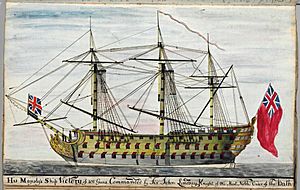John Lindsay (Royal Navy officer) facts for kids
Quick facts for kids
Sir John Lindsay
|
|
|---|---|

Lindsay as a young naval officer
|
|
| Born | 1737 |
| Died | 4 June 1788 (aged 50–51) |
| Allegiance | Kingdom of Great Britain |
| Service/ |
Royal Navy |
| Rank | Rear Admiral |
| Commands held |
|
| Battles/wars | Seven Years' War |
| Awards | Knight of the Order of the Bath |
| Spouse(s) | Mary Milner |
| Children | Dido Elizabeth Belle |
| Relations | Sir Alexander Lindsay, 3rd Baronet (father) |
Sir John Lindsay was an important British naval officer in the 1700s. He joined the Royal Navy during a big war called the Seven Years' War. He became an admiral later in his life.
He served in many places, including off the coast of France and in the West Indies. After the war, he even became a Member of Parliament for a short time. Later, he was in charge of naval forces in the East Indies and the Mediterranean Sea. Sir John Lindsay is also known for being the father of Dido Elizabeth Belle, a mixed-race daughter he entrusted to his uncle to raise freely in England.
Contents
Early Life and Family
John Lindsay was born in 1737. His father was Sir Alexander Lindsay, and his mother was Amelia Murray. Amelia was the sister of William Murray, 1st Earl of Mansfield, who became a very important judge. John grew up in a wealthy family.
His sister, Margaret, became an artist. She married her painting teacher, Allan Ramsay, which her parents did not approve of. But John remained close to his sister throughout her life.
John Lindsay joined the navy during the Seven Years' War, a major conflict between Great Britain and France. In 1756, he became a lieutenant and commanded a small ship called Pluto. He took part in an attack on a French port called Rochefort.
Serving in the West Indies

In 1757, Lindsay became a captain and took command of the HMS Trent. This was a 28-gun frigate, a fast warship. He served in the West Indies and near Britain until 1763. His ship helped try to capture Spanish vessels in the Caribbean Sea.
The Trent was part of a large British fleet that captured Havana, Cuba, from the Spanish in 1762. During this battle, Captain Lindsay bravely took over command of a larger ship, HMS Cambridge, after its captain was killed. For his courage, he was honored with a knighthood in 1764, becoming "Sir John Lindsay."
After the war, he returned to the West Indies on another ship, the HMS Tartar. This ship even carried one of the first accurate sea clocks, called a chronometer, for testing. He came back to Britain in 1765.
Family Life and Dido Belle
While serving in the West Indies, Sir John Lindsay had a daughter named Dido Elizabeth Belle in 1761. Her mother was an enslaved African woman. At that time, children born to enslaved mothers were also considered enslaved.
When Dido was very young, Sir John brought her to England. He asked his uncle, Lord Mansfield, and his wife to raise her. Lord Mansfield was a powerful judge who made important decisions about slavery. Dido grew up freely with her cousin and received an education. She lived with the Mansfield family for 30 years and inherited money from Lord Mansfield when he died.
In 1768, Sir John Lindsay married Mary Milner. They did not have any children together. He was also known to have another son named John from a different relationship.
Commander in the East Indies
From 1769 to 1772, Sir John Lindsay was promoted to commodore. This meant he was in charge of the British naval forces in the East Indies (near India). He was given the Order of the Bath, a special award, even though he was still a fairly young officer.
His job also included looking into how the British East India Company was dealing with local Indian rulers. This made him unpopular with the company, and he was eventually called back to Britain.
Battle of Ushant and Later Career
In 1778, Sir John Lindsay commanded the famous warship HMS Victory for a short time. He then commanded HMS Prince George in the Battle of Ushant (1778) off the coast of France. After this battle, he decided to leave the navy for a while. He refused to take any commands during the American War of Independence.
However, his skills were still valued. In 1783, he became an Admiralty Commissioner, helping to manage the navy. He was then put in charge of the British fleet in the Mediterranean Sea. In 1784, he even entertained the King and Queen of Sicily on his ship, HMS Trusty.
Soon after, his health began to fail, and he had to return to England. In 1787, he was promoted to rear admiral. This was an honorary title because he was too ill to take an active command. Sir John Lindsay passed away on June 4, 1788, at the age of 51. He is buried in Westminster Abbey, a very famous church in London.
Mansfield family tree
|
|||||||||||||||||||||||||||||||||||||||||||||||||||||||||||||||||||||||||||||||||||||||||||||||||||||||||||||||||||||||||||||||||||||||||||||||||||||||||||||||||||||||||||||||||||||||||||||||||||||||||||||||||||||||||||||||||||||||||||||||||||||||||||||||||||||||||||||||||||||||||||||||||||||||||||||||||||||||||||||||||||||||||||||||||||||||||||||||||||||||||||||||||||||||||||||||||||||||||||||||||||||||||||||||||||||||||||||||||||||||||||||||||||||||||||||||||||||||||||||||||||||||||||||||||||||||||||||||||||||||||||||||||||||||||||||||||||||||||||||||||||||||||||||||||||||||||||||||||||||||||||||||||||||||||||||||||||||||||||||||||||||||||||||||||||||||||||||||||||||||||||||||||||||||||||||||||||||||||||||||||||||||||||||||||||||||||||||||||||||||||||||||||||||||||||||||||||||||||||||||||||||||||||||||||||||||||||||||||||||||||||||||||||||||||||||||||||||||||||||||||||||||||||||
| Notes: | |||||||||||||||||||||||||||||||||||||||||||||||||||||||||||||||||||||||||||||||||||||||||||||||||||||||||||||||||||||||||||||||||||||||||||||||||||||||||||||||||||||||||||||||||||||||||||||||||||||||||||||||||||||||||||||||||||||||||||||||||||||||||||||||||||||||||||||||||||||||||||||||||||||||||||||||||||||||||||||||||||||||||||||||||||||||||||||||||||||||||||||||||||||||||||||||||||||||||||||||||||||||||||||||||||||||||||||||||||||||||||||||||||||||||||||||||||||||||||||||||||||||||||||||||||||||||||||||||||||||||||||||||||||||||||||||||||||||||||||||||||||||||||||||||||||||||||||||||||||||||||||||||||||||||||||||||||||||||||||||||||||||||||||||||||||||||||||||||||||||||||||||||||||||||||||||||||||||||||||||||||||||||||||||||||||||||||||||||||||||||||||||||||||||||||||||||||||||||||||||||||||||||||||||||||||||||||||||||||||||||||||||||||||||||||||||||||||||||||||||||||||||||||||
Images for kids



